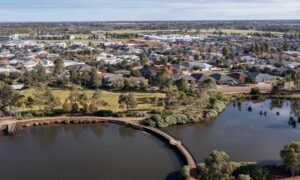Presented by State Opera of SA by arrangement with Opera Australia
Reviewed Saturday 13th October 2012
Ludwig Van Beethoven’s only opera, like most of his output, had a few revisions before attaining its final form. It is the third rewrite that we know today, and the overture is the fourth that hew wrote for this opera. The third of these overtures, known as the Leonore Overture No. 3, is often used between the scenes in Act II, but it is not needed in this production as the extremely clever set design allows for a very fast set change, and one that is so ingenious that the audience watch in awe as many tonnes of scenery moves from one setup to the next as smoothly as a Swiss watch.
There were numerous other composers at the time writing operas in the genre that came to be known as ‘rescue opera’ with wives risking all to save their condemned husbands, or vice versa. Beethoven’s opera consigned them all to oblivion, unable to match his genius and inventiveness. As the conductor, Graham Abbott says, from the orchestral viewpoint it is like playing three of Beethoven’s symphonies, one after another.
Gioacchino Rossini, André Ernest Modeste Grétry, Pierre Gaveaux, Simon Mayr, Luigi Cherubini, Ferdinando Paer, Pierre-Alexandre Monsigny, Jean-François Le Sueur, Étienne Méhul, Bedřich Smetana and, naturally, Wolfgang Amadeus Mozart, among others, all wrote works in the ‘rescue opera’ genre but, although they were well known and popular in their day, most people would recognise only a few of these composers’ names, or know them better for other areas of music, rather than opera. Fidelio overshadowed them all.
Beethoven increased the use of orchestral colour and, as he did with the symphony, he gave it great dramatic and emotional content, pointing the way forward for later German Romantic composers, like Giacomo Meyerbeer, Carl Maria von Weber and, through him, Richard Wagner.
This, of course, relies not only on a very knowledgeable and talented conductor, and Graham Abbott definitely fits that description, but he must have a highly superior orchestra at his command to bring out everything that Beethoven is asking of them. We, of course, have the Adelaide Symphony Orchestra in the pit, so that more than fulfils that criterion. Under Abbott’s guidance they play superbly, with particularly informed attention to the many dynamics in the score.
The essential story is very straightforward. Florestan is in a prison on trumped up charges for political prisoners and his wife, Leonore, has disguised herself as a young man named Fidelio and got a job at the gaol in order to find a way to rescue him. Things are complicated, though, as Marzelline, the daughter of the gaoler, Rocco, has fallen in love with Fidelio, throwing over her previous beau, Jacquino, the porter at the gaol. He is desperately trying to win her back.
Under orders from the Prison Governor, Don Pizarro, who is responsible for Florestan’s imprisonment, Rocco has been reducing Florestan’s food and water in order to starve him to death. The Minister, Don Fernando, is now on his way to inspect the gaol and Don Pizarro cannot wait any longer, as Florestan has already been reported as dead, so he orders Rocco to murder him. Rocco refuses, and Don Pizarro decides to do it himself, ordering Rocco to prepare a grave.
The tension builds as Leonore is now under pressure to save her husband before Don Pizarro can get to the lowest and filthiest dungeon where Florestan lies, already near death. Fidelio goes to assist Rocco prepare the grave, giving Leonore her chance to save her husband. Standing between Don Pizarro and Florestan, holding a pistol, things look bleak but at this moment there is introduced a deus ex machina, with the sound of a distant bugle announcing the arrival of Don Fernando. Matt Dempsey plays the offstage trumpet for this short fanfare, the echo of the large space in the wings giving it a feeling of distance, but also a fitting quality of otherworldliness.
This restaging of the Opera Australia production, originally directed by Professor Dr. John Hampe, is directed by John Wregg. Wregg’s extensive background in theatre shows in the performances that he has elicited from everybody, from the principals through to every member of the chorus, with excellent acting in evidence, alongside the superb singing voices.
The central role of Leonore/Fidelio was to have been sung by Miriam Gordon-Stewart but, sadly, she was unwell and unable to perform. The role was sung instead by soprano Nicole Youl, who is no stranger to Grand Opera, having sung major roles in many of the operas of Verdi, Puccini, and has even sung works by Wagner and Mahler. Beethoven’s opera is, like Wagner’s works much later, quite reasonably described as music drama. Youl brings all of that experience to the role and presented a truly wonderful performance as the woman drawing on every bit of inner strength and hope in her single-minded determination to succeed and willing to risk everything in the attempt. Her performance embraces a vast emotional range and her voice goes fluently from gentle whispers to moments of great power and passion.
The work opens with Marzelline and Jacquino, he trying to rekindle their romance and press her to accept him as a husband, and she trying to avoid the conversation, since she now prefers Fidelio. Virgilio Marino and Jessica Dean get plenty of mileage out of all this banter and comic interaction as they keep up their verbal sparring until interrupted. They make a great pair of young people with immature feelings of infatuation, trying to find real love. Rocco, too, likes Fidelio and is happy to allow ‘him’ to marry his daughter, Marzelline, much to Jacquino’s consternation, all of this leading to a quartet, known as the Canon Quartet, Mir ist so wunderbar (A wondrous feeling fills me).
The role of Rocco is sung by an Adelaide favourite, David Hibbard, who plays the role of the honest but not always overly bright gaoler. Who gives us a loveable man who tries his best to hold on to his moral dignity whilst being driven to perform the acts demanded of him by Don Pizarro, who never lets morality get in his way.
It is nothing unusual when watching a melodrama to cheer the hero, and hiss and boo the villain, but this is the first time that I have attended an opera where the villain got a round of good-hearted booing during the final bows. That says a lot about Douglas McNicol’s very believable characterisation in the role of the despicable Don Pizarro, the corrupt Prison Governor, and of his popularity with Adelaide audiences. He oozes menace with every move he makes and every note that he sings in a powerful performance.
Florestan is sung by the tenor, Richard Crawley, and here was a performance as magnificent as that of Youl. From his first appearance, at the start of the second act, one cannot help but feel for this pitiable, greatly wronged man. His singing of his faith in the Almighty, Gott! Welch Dunkel hier! (God! What darkness here), followed by his vision of Leonore coming to release him, In des Lebens Frühlingstagen (In the spring days of life), tear at the heart strings.
Even in his brief appearance as Don Fernando, Robert England creates a character that rings true, an air of command and an almost regal composure can be seen in his portrayal. There are no two dimensional characters in this opera, no matter what the size of the role. All roles are important, and that is the way they have been treated in this opera.
The men of the State Opera Chorus portray the many political prisoners held in dingy underground cells and, as they crawl and drag themselves out of their hell-holes when Fidelio convinces Rocco to let them out into the courtyard for a short time, they offer a very convincing performance of men who have not seen the outside of their cells for years. As they sing O welche Lust (O what a joy) one can feel that joy in their voices, then with
Leb wohl, du warmes Sonnenlicht (Adieu, warm sunshine) when they are driven back to their cells shortly after, their voices are filled with just as strong a feeling of despair. Wregg’s direction and the efforts of Chorus Master, and State Opera’s CEO, Timothy Sexton, have done wonders with this very moving scene. Norbert Hohl and Thomas Millhouse, playing two of the prisoners, add further quality to this with their fine solos. This was a memorable moment, filled with genuine pathos.
The women of the State Opera Chorus finally put in an appearance in the final scene, when the men are all released by Don Fernando and they all rejoice at being reunited. Even in this, we see the same attention to detail in their characterisations.
John Gunter’s set design is a massive construction that consists of several moveable sections of high, dark, heavy prison walls. At each scene change these enormous sections slide silently and smoothly from the prison gates, to a courtyard, to the underground prison of Florestan, and to the scene of freedom outside the walls with a wide open sky dominating. Obviously, the lighting design of Nigel Levings is critical in making these different scenes work, especially the dungeon scene which must be dark to convey the impression of being deep underground but sufficiently lit so that we can see the action. He has lit this scene with vague, watery shafts of light creeping through gaps in the timber and stone. The whole thing is so oppressive and claustrophobic that, even well out in the auditorium, it makes one feel somewhat uncomfortable. Gunter also designed the costumes, with everything from ragged scraps of clothing on the prisoners to the elaborate robes of the Minster all looking just the part.
It is almost a quarter of a century since this sensational piece was last performed in this state, so this is a rare opportunity to see an opera that is pivotal in moving forward from what had been, pointing the way to what was to come with the eventual appearance of Wagner’s Der Ring Des Nibelungen. One cannot help but wonder whether Wagner would have created his massive works had it nor been for Fidelio and Beethoven’s exciting approach to writing that opened up enormous possibilities to later composers.
This is definitely a work that should be in every opera lover’s diary this week, with only three more performances left. Make sure you are not the one bemoaning the fact that your tardiness in booking tickets caused you to miss it.
Reviewed by Barry Lenny, Arts Editor, Glam Adelaide.
Venue: Festival Theatre, Adelaide Festival Centre, King William Road, Adelaide
Season: 7:30pm Tues 16th, Thurs 18th and Sat 20th October 2012
Duration: 2hr 30mins (intvl 20mins)
Tickets: adult $55-175/conc $45-145
Bookings: BASS 131 246 or online here





















